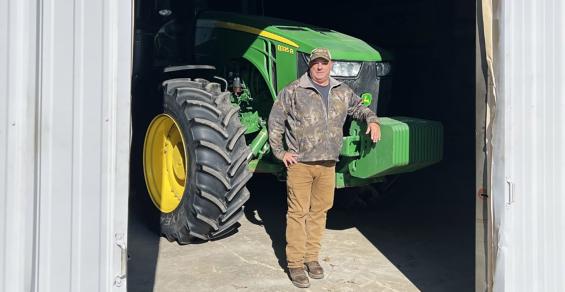Arkansas farmer looks back on 2022 and plans for 2023
Farmers faced challenges like none other in 2022, and Scott Matthews of Poinsett County, Ark., is happy to close the door on his 33rd production year. The brutal growing season followed by favorable late summer weather brought enough momentum to roll through harvest stronger than expected, according to Matthews.
“August bailed us out, and we had fantastic harvest weather. The combine never got rained on, and we got in a lot of fall field work,” he said.
Tough Year
When asked to reflect on his farming season, Matthews jokingly referred to a classic drawing toy and said, “We had to ‘Etch-A-Sketch’ this one.”
Scott Matthews, Poinsett County, Ark. (Whitney Haigwood)
Matthews recalled the twists and turns of the year. Fall weather in 2021 prevented fieldwork, and farmers started the 2022 season with spring tillage while facing rising input costs.
“Inputs started to creep up a little in January. At that point, it was not bad. Then we got into April. Suddenly planting was delayed because of weather, and inputs went through the roof,” he said.
In northeast Arkansas, farmers were left with obstacles to overcome as fertilizer skyrocketed to around $1,000 per ton and diesel jumped to over $4 per gallon.
“When prices went up, our production loan went out the window. It had been set up months prior, and we still had fertilizer to apply and diesel to burn,” he added.
Rice planting was delayed slightly, but still timely. Matthews said this shift in plant date turned out better than expected, pushing the crop back enough to protect it from the brutal summer heat that was to come.
Soybeans were hastily planted on the farm from mid-May through the first of June. Then the drought hit, and irrigation became an issue.
“Rice is the money crop,” he said. “We had just put out fertilizer, and it was at a critical growth stage. Normally, we can flood a rice field in four to five days. This year it took 10 to 12 days.
“We were so tied up to staying on top of our rice that we could not help our soybeans. There were times we just could not irrigate them.”
After rocking through a tough growing season, the crops caught a break during the dog days of summer. August brought rains and cooler temperatures, leading to a dry harvest with perfect conditions.
Harvest Weather
Matthews described harvest weather as the best he has seen in his life, but the combines did not roll into the field as early as expected.
“We got to the point of the season where we typically start to harvest,” he said. “The weather was perfect, but the rice was not ready. That will make you panic a little. It was painful to wait on the moisture to fall out.”
Moisture was trapped and the crop needed some rain to evaporate and dry down. This issue kept them on the verge of moisture problems throughout harvest, but Matthews reported that it was a trade-off in the end with better milling yields.
“If you catch a couple of rains, your milling usually lowers, and we were not punished at all for that,” he added.
Overall, rice yields were steady on the farm. Matthews plants only hybrid varieties, known for taking the weather better. They certainly did so this year. He said his yields were only down by 2% to 2.5% and considers it a victory after the brutal growing season.
Another bright spot of the season was a new hybrid variety that proved effective against barnyardgrass – a nearly uncontrollable weed on the farm.
“This year, I tried a Max-Ace rice with Highcard herbicide on a small field,” he said. “We got our applications out timely and followed the label to the letter. Even in adverse weather, the field was clean, and the system controlled our barnyardgrass problem.
“I really could not tell any difference in yield. This variety performed like all the other hybrids, but the chemical control was completely different.”
2023 planning
Rice and soybean acres will stay the same on Matthews’ farm next year, and he hopes to plant more of the Max-Ace rice.
He also expects to see more rice acres planted in Arkansas for 2023.
“For one, people like to plant rice,” he said. “Last year, spring weather delayed rice acres, and many got switched to soybeans and corn. I think those will go back into rice, and I look for Arkansas to be back up to 1.4 million rice acres in 2023.”
Fall tillage may also determine acreage next year. Farmers covered a lot of ground this fall with excellent conditions.
“Weather has beaten us up the last four or five falls and resulted in almost no tillage,” he said. “This year, we were able to get in a lot of fall fieldwork, and it will make for a less hectic spring.”
Conditions also allowed for chicken litter to be spread across some fields this year, but Matthews noted that logistics limit availability. He also did not apply conventional fertilizer this fall. Prices at $800 per ton made it cost prohibitive at the time.
These historically high input costs also present difficulty in booking prices for 2023.
“We are waiting with our finger on the trigger for booking, but it is hard to decide when to book,” he said. “It is so far out, and we are cautious right now. It is kind of a guessing game at this point.”
In closing the doors on 2022, Matthews concluded that farming requires some amount of luck.
“When it comes down to it, you have to get lucky sometime,” he said. “Next year may be the year we need to get lucky. Hopefully, we won’t have to ‘Etch-A-Sketch’ two years in a row.”




